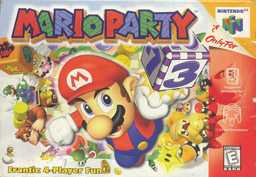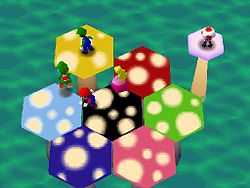Mario Party (video game)
| Mario Party | |
|---|---|
 NA Nintendo 64 cover artwork | |
| Developer(s) | Hudson Soft |
| Publisher(s) | Nintendo |
| Director(s) | Kenji Kikuchi |
| Producer(s) | Shinji Hatano Shinichi Nakamoto |
| Composer(s) | Yasunori Mitsuda |
| Series | Mario Party |
| Platform(s) | Nintendo 64 |
| Release date(s) | |
| Genre(s) | Party |
| Mode(s) | Single player, multiplayer |
| Distribution | 256-Megabit cartridge |
Mario Party (Japanese: マリオパーティ Hepburn: Mario Pāti) (also known as Mario Party 1) is a party video game for the Nintendo 64 game console, developed by Hudson Soft and published by Nintendo. It was released in Japan on December 18, 1998, in North America on February 8, 1999, and in Europe on March 9, 1999, as the first game resulting from a partnership between Nintendo and Hudson Soft, which began in May 1998. Mario Party is the first game in the Mario Party series, and is followed by Mario Party 2.
Packaging
The packaging for Mario Party features Mario jumping to hit a dice block, an item in the game which determines how many spaces the character moves on his or her turn. The most prominent number on the block is 3 and it is positioned below the title of the game. This may mislead consumers into thinking this game is Mario Party 3.
Gameplay

Consisting of 56 mini games (plus 3 hidden single player mini games), Mario Party takes the form of a traditional board game, with players taking turns to roll (hit) the dice block and move ahead the number of spaces shown ranging from one to ten. There are many different types of spaces players can land on, each producing a different effect. The primary objective of the game is to collect more stars than any other player. The winner of the game is the player with the most stars after all the turns have been completed.
On some levels there are only one star at a time, while on others there could be many stars at once, appearing randomly on a space on the board where it remains until bought by a player for the specific amount of coins stated (20). After a star is collected, a new one appears on a different space on the game board or stays in the same place depending on the stage chosen. Stars can also be stolen from other players by passing a certain location on the board where a Boo resides—the player must then pay Boo 50 coins for the service of him stealing stars; coin stealing is free.
A secondary objective is to gather coins as well, for they are necessary for buying essential items such as stars and determine the game winner in the event of a tie. Coins are earned by landing on blue spaces or winning mini-games. Coins are lost by landing on red spaces, landing on a Bowser space, or losing certain mini-games.
At the end of each round of play (i.e. after each of the four players have taken their turn) a random mini-game commences. The mini-games are generally short (about a minute in length), and fairly simple. There are 56 of them in total, divided into 4 different categories.
- Four-player mini-games may be divided into three types:
- The cooperative games, in which all four players collectively win or lose.
- The competitive free-for-alls, in which players must compete against each other in order to win a limited number of coins.
- The non-competitive free-for-alls, in which players accrue coins independently of one another and one player's loss is not automatically another's gain.
- 2-on-2 mini-games place players on teams, so they have to cooperate with others in the mini game to win (even though they're still competing against each other in the main game).
- 1-on-3 mini-games have a team of three against a lone player. Often, the game's objective is for either the lone player or the team of three to survive for a certain amount of time while the opposing player/team tries to take them out. The team of three must cooperate in order to win.
- One-player mini-games only occur during a round when a player lands on a One-player mini-game space. They give a single player an opportunity to earn (or lose) coins depending on his or her performance in the mini-game.
At the end of the game there are three bonus stars given out. The coin star award is given to the player who collected the most coins overall during the game, the mini-game star award is awarded to the player who collected the most coins in mini-games, and the player who landed on the most "?" spaces earns the Happening Star. It is common for more than one character to be awarded the same bonus star; this happens if there is a tie for the category in question. The person with the most stars after the bonus awarding has concluded is declared the winner. In the event of a tie, the player with the most coins wins, and if two players have the same number of both stars and coins, a dice block will be rolled to determine the winner.
Mini-games happen at the end of each round or occasionally during a round when a player lands on a Bowser space or One-player mini-game spaces. In most situations, the winner(s) of a mini-game receive ten coins for their victory. In some mini-games, the losing player(s) have to pay the winner(s) a sum of coins.
Players can choose to play as Mario, Luigi, Princess Peach, Wario, Yoshi, or Donkey Kong.
Modes
Adventure Mode
The standard mode of play, as described in Gameplay above. Up to four players play a board game interspersed with mini games, trying to collect as many stars as possible by the end of a set number of turns. The coins and stars earned in Adventure Mode are tallied up and transferred to a fund which the player can use to unlock things in the game.
The type of mini-game (4-player, 1-vs.-3, and 2-vs.-2) is determined by what color the players' panels are. If all four players have the same color panels, a 4-player game is selected. If there's 1 blue panel, and 3 red panels or vice versa, a 1-vs.-3 game is selected. If there are 2 panels of both colors, a 2-vs.-2 game is selected. If there's a green panel, the color will switch to either red or blue (usually blue) randomly.
Mini-Game Island
A one-player mode in which the player navigates a world map and must win mini games in order to progress across the map. Winning mini games gives the player coins, and collecting 100 coins grants the player a life. Losing a mini game causes the player to lose a life. If the player loses all of his or her lives, the game ends, and the player must resume from where he or she last saved. After beating 50 mini games and reaching the goal, a waiting Toad can be found. The player will then be challenged to a game of slot car derby. Once the player wins, Bumper Ball Maze 1 and Bumper Ball Maze 2 (If the player completed all mini games preceding the goal) are unlocked; upon winning 1 and 2 in the mini-game shop, Bumper Ball Maze 3 is unlocked. The Bumper Ball Maze mini games are only playable in the mini game shop.
Reception
| Reception | ||||||||||||||||||||
|---|---|---|---|---|---|---|---|---|---|---|---|---|---|---|---|---|---|---|---|---|
| ||||||||||||||||||||
Mario Party received mostly positive reviews upon release, with praise to the party aspect of the game. However, its most common criticism is its apparent lack of enjoyment without multiplayer. GameSpot explains, "The games that are enjoyable to play in multi-player are nowhere near as good in the single player mode. Really, it's that multi-player competitive spark of screaming at and/or cheering for your friends that injects life into these often-simple little games, and without it, they're just simple little games."[5] IGN took a similar line, saying that it was the interaction between players rather than the interaction with the game that made Mario Party fun. Another common criticism was the game's dependence on luck rather than skill, though this was seen by many to add to the game's board game atmosphere, as players who were comfortably in the lead one turn could be losing the next.
Sequels
The popularity of Mario Party has led to nine sequels: Mario Party 2, 3, 4, 5, 6, 7, 8, 9, and 10, as well as Game Boy Advance, Nintendo DS, Nintendo 3DS, and E-Reader versions. A Mario Party for arcades called Super Mario Fushigi no Korokoro Party was released only in Japan, making a total of twelve games in ten years, including at least one every year except the years 2006, 2008, 2009, 2010 and 2011. The frequency of the sequels has led to some criticism regarding the games being unoriginal, as many ideas from previous installments of Mario Party have been recycled throughout the series.[7][8] This is evident in the mini games in the later installments of the Mario Party series which do not differ much from earlier Mario Party mini games. However, new Mario Party games have continued to sell well, and Mario Party is still a very popular franchise.[9]
Controversies
In Mario Party, certain minigames required players to rotate the controller's analog stick. Some players reportedly got blisters, friction burns and lacerations from rotating this stick using the palms of their hands instead of using their thumb.[10][11]
Although no lawsuits were filed, around 90 complaints were received by New York's attorney general's office and Nintendo of America eventually agreed to a settlement, which included providing gloves for anyone who had hurt their hand(s) while playing the game and paying the state's $75,000 legal fees. At the time, providing gloves for the estimated 1.2 million users of the game who might have been affected could have cost Nintendo up to $80 million.[10][11]
The analog stick rotation has been used sparingly since Mario Party 2. Despite Nintendo's current analog sticks are now better suited to play these games than the hard plastic of the N64 controller, Mario Party has not been re-released for the Virtual Console. For the Wii Virtual Console, Nintendo skipped it and instead re-released Mario Party 2. Although planned for a re-release, it was dropped because of the controversy caused by the analog stick rotation gameplay mechanic.[12] There are currently no plans to re-release it for the Wii U Virtual Console.
Another was Wario and Luigi saying "Oh, my God!" in the Japanese version of the game. This was changed in the US version to avoid religious issues. Wario's line was replaced by "D'oh, I missed!" in the Western version and Mario Party 2.
References
- ↑ "Release Summary: Mario Party". GameSpot. Retrieved May 10, 2010.
- ↑ "Mario Party Reviews". GameRankings. Retrieved May 10, 2010.
- ↑ 3.0 3.1 "Mario Party Reviews". Metacritic. Retrieved January 20, 2009.
- ↑ Crispin Boyer, Dan Hsu, John Ricciardi, Shawn Smith (April 1999). "Mario Party Review". Electronic Gaming Monthly (117): 122.
- ↑ 5.0 5.1 Joe Fielder (February 8, 1999). "Mario Party Review". GameSpot. Retrieved January 20, 2009.
- ↑ Peer Schneider (February 11, 1999). "Mario Party Review". IGN. Retrieved January 20, 2009.
- ↑ Mario Party 7 for GameCube Review – GameCube Mario Party 7 Review
- ↑ Mario Party 6 for GameCube – Mario Party 6 Game Cube – Mario Party 6 GameCube Game
- ↑ Nintendo Gal
- ↑ 10.0 10.1 http://www.gamespot.com/news/nintendo-issues-game-gloves-2541755
- ↑ 11.0 11.1 "Nintendo to hand out gaming gloves". BBC News. March 9, 2000. Retrieved March 22, 2011.
- ↑ "Mario Party 2 Review". IGN. December 20, 2010. Retrieved March 22, 2011.
External links
- Official Nintendo Japan Mario Party site
- Mario Party at MobyGames
- Mario Party at the Internet Movie Database
| ||||||||||